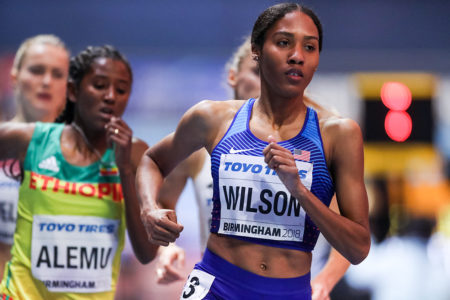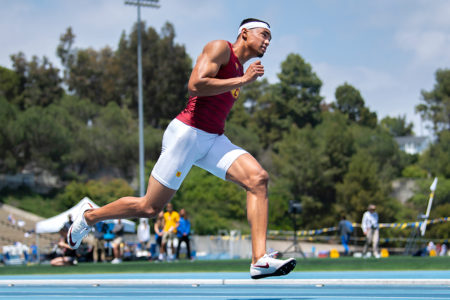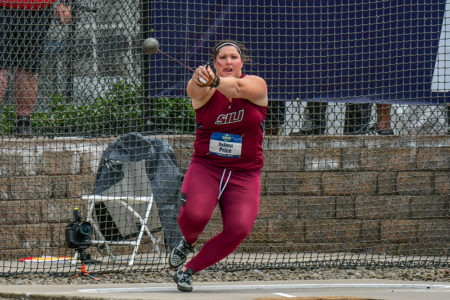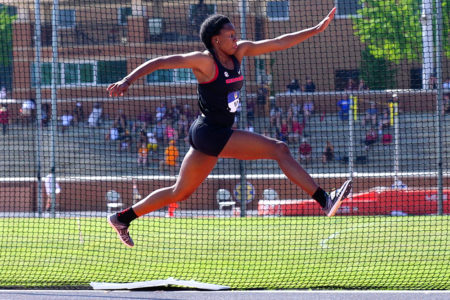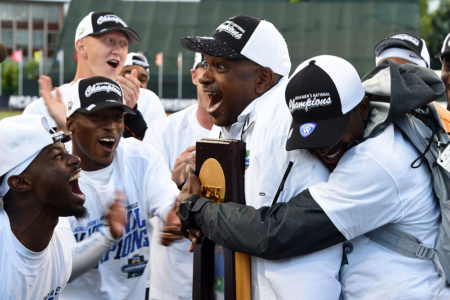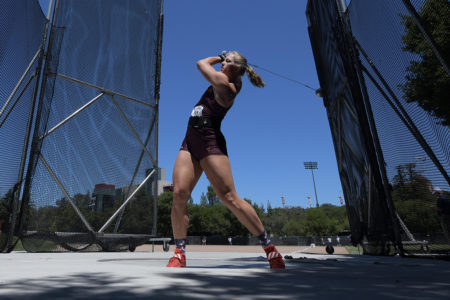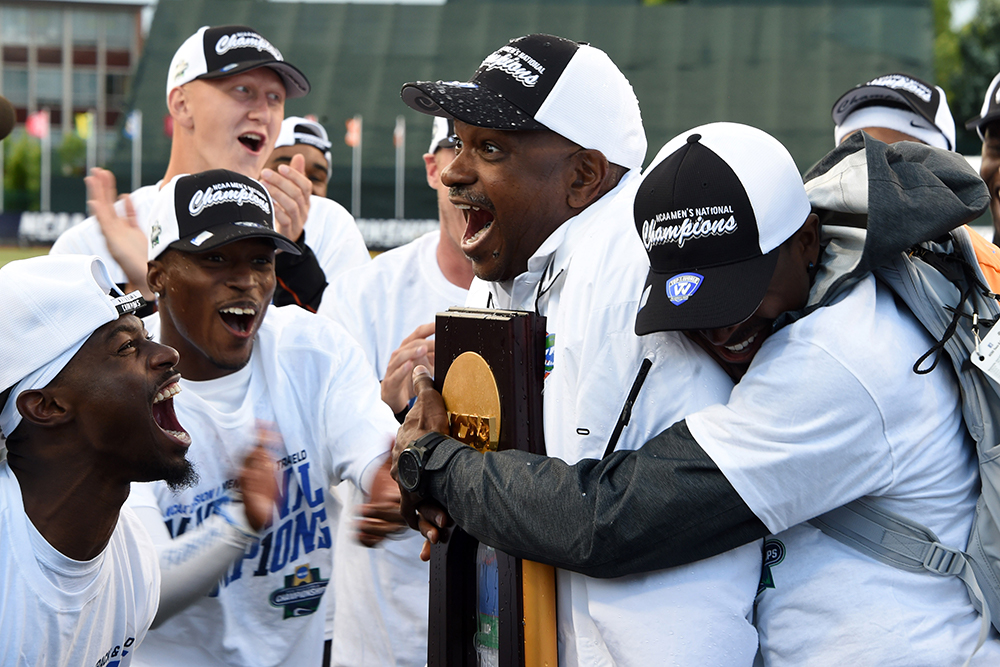
“It was amazing, man. Absolutely amazing,” says Florida head Mike Holloway. His Gators have just swept the men’s and women’s SEC titles for the first time. Still riding the high from the victories, Holloway is quick to give thanks, not to his “stars,” but to the names that didn‘t make the headlines:
“You think about Kyren Hollis, almost a full-second PR to place 4th in the 800. Sam Arenholz, fighting his tail off and getting that 8th—1 point in the 1500. Nikki Stephens falling in the 400 hurdles and coming back and splitting 51-high in the 4×4. People stepped up. I wouldn’t call them surprises. They’ve been training well. We knew they were capable.”
Holloway, popularly known as “Mouse,” knows that a team is not just about its stars. And he knows how to put one together. He has been part of the Gator program for 22 years and has directed the combined men’s and women’s team since the 2007–08 season. Overall, 8 national team titles and more than a score of top-3 finishes have come to Holloway-guided Gator squads.
To say that under his direction the team from Gainesville has become a perennial force in the collegiate world is understatement. Since ’96, the Gator men have won 31 NCAA titles in the sprints/hurdles/relays, 3 more than any other program. Small wonder that going into the postseason Our formchart still has the Gator men tabbed at No. 1.
And the women—tied for No. 6 on the formchart after the SEC—have not been slacking. Six individual national crowns are topped by Kyra Jefferson’s 22.02 CR in the NCAA final last year.
Holloway insists there’s no secret magic behind the success story: “It’s a mindset that starts during the recruiting process. We talk to them about that; that it’s our major goal to be at our absolute best at the National Championships. That’s kind of who we are. That’s our tradition here. As a coaching staff, we just really design our training programs to be ready for those situations.”
He continues, “I’ve always been a guy that just shows up every day and I work hard. I remember when back as a high school coach I just wanted to do well. When I came to Florida I wanted to be the best assistant coach I could be. And then when I became the head coach I told [then-AD] Jeremy Foley—I gave him my word—that at the end of every year he’d be proud of the track & field program.
“I said, ‘I can’t promise you championships, but I can promise you we’re going to compete hard.’ As this thing has unfolded, I’d be lying if I told you, ‘Oh yeah, I knew we were going to win 7 national titles.’ I didn’t even know we were going to win 1. But the only thing I did know is I can come in here and work hard every day. And I’ve been blessed to have a staff around me to trust me. They believe in me as I believe in them. We work hard together. We believe in each other. And that’s why it works here, we just grind every day.”
Holloway shared with us his thoughts on the sport, as well as the athletes that make up the Gator powerhouse:
Chasing Times
Some in the college world say the sport should be about more than chasing qualifying times and national titles, but Holloway makes no apologies, saying he is just responding to reality: “If they want more scoring meets then they better make the meets count for something. You know, right now the system is based on qualifying, especially indoors. So when you go indoors, you’re going to go to meets and the competition that can help you get the marks that you need to qualify for the indoor national championships. As simple as that. Our program is set up based on what the NCAA wants us to do. If the SEC or the NCAA mandated that we had to have more scoring meets, we’d do it.”
The Competition
With sprint power resurging in places like USC and Houston, Holloway says that will not change his approach. “Just be honest with you,” he says, “I try not to think about those teams. We have a certain skillset. We have a group of athletes who do things well and so we try to get our kids ready to be at our best because I can’t control what USC or Houston or Texas Tech or anybody else does. My major thing is to make sure we finish on top. We’ve got to take care of the Gators. We can’t worry about somebody else because we can’t control them. We’re just going to go in here, and whether it be this weekend at the conference championships or four weeks from now at the NCAA meet, take care of our lanes, our spaces, our rings, our runaways. We can’t think about anybody else.”
The 4 x 400
So often, many of Florida’s wins come down to the final event. It can be nerveracking for everyone involved. “I would much rather we could win before the meet was over,” Holloway laughs. “Unfortunately, outdoors it’s never been the case. It’s always come down to, ‘We gotta do this or that in the 4×4.’ There’s been a couple of times indoors where we’ve gone into the 4×4 and the meet was won already. That’s a good feeling.
“For me it’s just this part of the process. I think that there were a couple of meets in the past where we’ve lost by a couple of points because we didn’t have a good 4×4, so that’s why we have always made that charge, that I need to make sure we have a good 4×4. That’s gotta be the worst feeling in the world, you know, watching the last event of the meet, knowing that you don’t have a chance to win it because you don’t have a good 4×4.”
He scouts potential Gators with the 4×4 in mind: “We recruit a broad-based team in mind and we’ve been fortunate enough to have a good group of quartermilers and then we have athletes like Grant [Holloway] who can just step up and run it. But if you look at the past, it has been mostly four or five quartermilers that we’ve had on the roster that have been able to get it done.”
Competing In The SEC
Being in the nation’s most competitive conference can be tough: “Chris Bucknam at Arkansas likes to call it ‘the meat grinder.’ It’s just a tough meet. Whether you’re in the team title hunt, whether you have a group of individuals that can do well in certain event areas, everybody walks into this meet this weekend with the attitude that ‘We’re going to compete, we’re going to compete hard,’ and that’s what makes our league so good. I mean it’s because everybody here, no matter what school, has either a great team or smaller group of individuals and they want to leave their mark on the meet. Nobody wants to walk out this week feeling like they got nothing accomplished. So everybody comes in here and it’s just a group of great competitors, you know? Can we get at each other a little bit on occasion? Absolutely. But, I wouldn’t say we’re cutthroat or anything like that.”
The Team’s Image
With each year, more people in Gainesville recognize that the track & field program is one of the jewels of the Gator athletic department. Holloway, who bowls for recreation, measures it by how many people at the bowling alley are saying things: “On the men’s side [our reputation] proceeds us as most people know what we’ve done. Our women’s team has been very good. We’ve been solid for a while now and we still have to explain to people that we have a good women’s program.
“I think that if we were a mediocre men’s team, our women’s team would be talked about a lot more. Our men are so good that our women just get overshadowed. And that’s difficult for us, difficult for the women. Not many people are talking about the fact that our women were 4th indoors this year. They were 5th outdoors last year. We’ve had a lot of good success. People tend to think that we don’t care about the women—not true at all. We care just as much for the women as we do for the men.”
Coaching His “Stars”
Grant Holloway continues to spark the headlines. Always gung-ho, the sophomore phenom is always willing to do whatever he can to score points for the team. Coach Holloway admits he has to hold him back: “Sometimes. All the time. He’s the ultimate team guy. He’ll do whatever. He was joking the other day saying he jumped 7-1 in the high jump in high school, and he was saying, ‘Coach, I could score in the high jump!’ I was like, ‘Yeah, sure you could, but we’re not high jumping.’ He wants to do everything.”

Coach Holloway adds, “We don’t run him a lot. I mean that’s the thing. He does a lot at the Conference and National meet, but if you look at it, he goes to meets, he does long jump, runs a relay. Florida Relays, he ran the high hurdles and a couple of relays. Tom Jones, he ran the high hurdles and a couple of relays. We run every other week. We do a lot of preparation for the championship season with them. He’s no different than anybody else in the team. We try to get everybody to prepare to be ready to do our best at the conference, regional, and national meet.”
Then there’s KeAndre Bates, a 3-time NCAA champion in the horizontal jumps: “KeAndre is KeAndre, as we say. I learned early on that we have to let him be his own person and he has a way of processing things and thinking through things. I have to let KeAndre talk himself through things. I have to let KeAndre process things in his mind and coach [Nic] Peterson and he have a certain dynamic and then I try to add to that. They’re both kind of hyper so I’m kind of the calming influence on both of those two.
“The big thing with KeAndre is we’ve always been able to count on him when we’re at the big meets. You know, he had a bad SEC Championships this year indoors. He just had some things going on, these things happen. And he told me, he said, ‘Coach, I got you at Nationals’ and he had us at Nationals. He does what he does.”
Hakim Sani Brown is one of the most interesting new Gators. The Japanese 19-year-old was 7th in the World Championships 200 last summer. “People, they see he ran 10.05 and he ran 20.32 and was a finalist in the 200 at the World Championship, but they don’t realize he’s a kid,” says Holloway. “He’s from Japan. He’s living away from home for the first time: new foods, new people. He’s learning a new language, he’s got a lot going on with his life.
“Honestly, we’re trying to let him adjust to being a college student. He didn’t do a lot of training at all during the fall. He didn’t do much during the indoor season. That’s why he didn’t open up until the SEC [indoor] meet and that was just to see where he was. He’s coming around nicely, his training is going really well. He’s a great, great kid.
“I just felt like that I would be doing him a disservice if I rushed him into this, especially with all that he had going on around him. People, they’re not thinking about what he goes through on a daily basis when he would walk into some place and want to order something and people didn’t really understand what he wanted. He’s sitting with tutors for 3 or 4 hours a day, stuff like that.
“The big reason his mother wanted him here was because she wanted him to get an education. It wasn’t just about track & field. We know he can run fast. But if I don’t let him get a good base for educational purposes, he’s never going to survive here. And he’s doing a great job in the classroom and now he’s starting to run well, because like I said, I was never worried about that. I knew he could run.”
Florida is not just about speed. There’s also a strong throws contingent that scored 42 points (23 by the women) at the SECs last weekend. And 15 of those points came from the three hammer guys, Anders Eriksson, Thomas Mardal, and A.J. McFarland.
“You have to be around that group to understand them,” Holloway points out. “They’re three totally different guys, but they’re three perfectionists in their own right. I watch them work with my throws coach, Steve Lemke. They challenge each other, they pick each other up, they give each other crap every day. It’s just awesome. If we’re going to be challenging for national titles, those three guys are a big part of that.
“The freshman, Thomas Mardal, I call him ‘Shoulders.’ If you’ve seen him, you know why. His shoulders are just incredible. Coach Lemke does this flying 30 testing in the fall and Thomas was 2.94 for a flying 30, so he’s wired like some of my hurdlers. Anders is the ultimate technician and AJ is just the brute that comes to practice every day and just refuses to get left behind. So it’s a lot of fun watching those guys.”
One of the big Gator wins at SECs came from junior Sharrika Barnett, who PRed at 50.69 to win the 400 by nearly a second: “Rika B, she’s doing phenomenal. The thing with Sharika is she started to believe, she started to trust her ability,” says Holloway. “She started to really believe that she can do this.
“Coming out of high school, she wasn’t sure. And I kept telling her, ‘Look, you can run 50 seconds, I’m not so sure you can’t run 49 seconds someday.’ And she would kind of smile and laugh, ‘OK, Coach Holloway.’ And then she started to believe. Now, she’s really starting to trust and understand the process here and I think we’ll see some big things out of her for the remainder of this year and next year as well.
“Ever since we took over the program, we’ve had an NCAA qualifier in every event. All 21 events. And in 17 of the 21, we’ve had a scorer. That’s something that just gets lost in the glitz and glamour of what the men are doing. The women have been overshadowed and they’ve been doing a great job.
“You talk about Darielle McQueen [3rd in the SEC with a PR 21-10/6.65], a girl that was a 19-footer, that’s jumped well over 21-feet. A girl like Lloydricia Cameron, who was a 48-foot shot putter out of high school and now she’s throwing 58-feet [she finished 4th in the SEC SP, and 2nd in the DT]. The list goes on and on. I’m just very proud of our women because even though they don’t get the attention the men get, they just come to practice every day and they keep grinding and grinding.”
Coaching Professionals
From a coaching perspective, Holloway has to balance his pros with his collegians. “They don’t work out together,” explains the ’12 U.S. Olympic assistant. The [pros] come out at 11:00 in the morning, they get it done and then we get a little break. Coach [Adrain] Mann and I run upstairs and get a sandwich or something and we come back down and we start with the college team. It’s not fair for us to mix them because then none of them would get the attention they deserve.
“At the end of the day, my job is to produce NCAA champions, SEC champions, not just from an individual standpoint but from a team standpoint. So I have to make sure that we maintain our focus on that. We love our post-collegians and we do everything we can to ensure their success, but we can’t water down what we do for the team because then we won’t have a job and I would have a problem.”
From the athletic department, Holloway has received nothing but positives for creating an environment that the alumni want to train in: “Our administration loves to have our post-collegiate athletes—I call them ‘Gator Greats’—that did so much for the program. They love having them around. As long as they’re being good people and they’re adding to, not just to the track community, but the Gainesville community as a whole. It doesn’t hurt that some of these alumni have won major international hardware, led by double Olympic champion Christian Taylor.
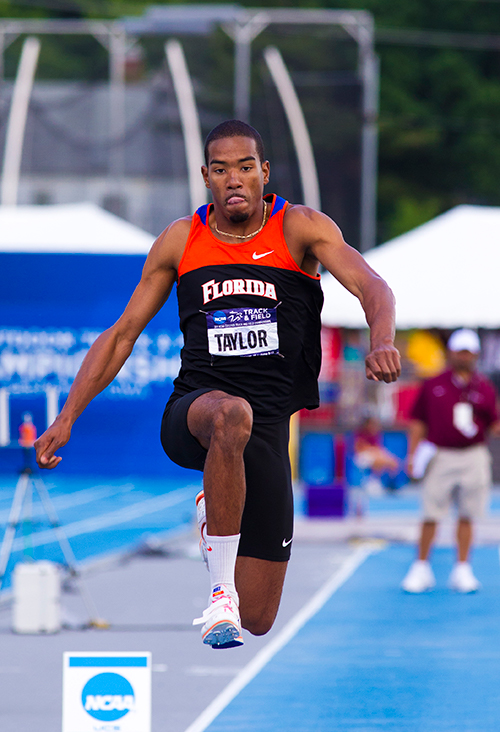
“Christian comes back and trains all fall. He has his own coach, they have a training program, but Christian’s out there in the morning all the time. [Hurdler] Eddie Lovett comes back and trains all the time and Will Claye stops by every now and then. Omar Craddock and Marquis Dendy are still in town working with coach [Nic] Petersen.
“Marquis is also a volunteer assistant coach. That’s great for us that we have that many people that have had that kind of success that still want to be around. It’s always good to look out on the track, you know, every morning at 8:30, 9:00 and there’s Christian just piling away. It’s great.”
It’s hard to make the transition from college star to successful professional. Holloway has worked through the process with many of his athletes and is cognizant of the challenges: “The biggest thing is when you become a pro, all of a sudden all the perks you had as a collegiate athlete aren’t there. You might be traveling by yourself, the facilities are not readily available, the physios, the trainers. I think the biggest thing is also they have to travel without their coach sometimes. It’s like we do a lot more talking and practice about mental cues, things to think about before races because I’m not there to give them. The other thing too is it’s just confidence. They have to believe they belong at that level because that is a dog-eat-dog world out there. Everybody that lines up is trying to make a living and looking at you as somebody trying to take money out of their pocket, food out of their mouth. So you have to have that same mentality or it won’t work. It just won’t work.”
One of the new pros is Kyra Jefferson, who won the NCAA 200 last year in a collegiate record 22.02: “I’ve been telling Kyra for a year and a half she could run 21 seconds and she laughed at me every time that I said it. We had a conversation at the Regional meet [last year]. She was very upset because she didn’t think she was running fast enough and, ‘I don’t know what the problem is. I won my heat, qualified for Nationals, but I should be running faster.’
“I said, ‘I want you to have this conversation with me in two weeks.’ After she ran the 22.02, she said to me, ‘OK, I get it now. It wasn’t time to run 22-flat yet.’
“So that’s the thing with Kyra, that’s been her whole career at Florida, is if she just trusts the process. You don’t think you’re going to walk out there and just dominate those people now. That doesn’t happen that way and we’ve got to be patient and just chip away little by little and the goals will be to be great next year and even better in 2020 when it counts for the Olympics.”
Similarly, Eric Futch won the NCAA 400H last year, and is also making the pro transition after earning a No. 9 in the T&FN World Rankings.
“Eric’s a battle; he needs motivation,” Holloway explains. “This is a tough year for Eric because there’s no major championships and he started off really slow but he’s coming around now. He knows there’s some big competitions this summer as far as Diamond League meets and stuff like that he wants to get ready for.
“But you talk about the ultimate team guy, a lot of the things you saw Eric do in college were for his team. When we lost [400 runner] Kunle Fasasi last year during the outdoor season, when it happened in practice, Eric looked around and goes, ‘Guys, next man up, we’ve got to get ready.’ You know, that’s just who he is. He’s a great leader. And if you want a guy that you could talk to about, NBA, NFL, college football and basketball, that’s your guy. He’s my go-to guy when I want to talk to my buddies about sports. I go to Eric first to get my stats right.”
TJ Holmes trained alongside Futch last year, placing 6th at NCAAs, then rebounding with a 48.44 PR at USATF that put him on the team for London, where he placed 5th and ended up No. 10 in our World Rankings.
Says Holloway, “TJ is a sleeper. People keep saying, ‘Where’d he come from?’ But you have to be around him every day. We call him ‘Coach Holmes’ because he just analyzes everything that he does. He can tell you what other people are doing wrong. So we just gotta get TJ to cut his brain off sometimes and just go run. But I’m very excited about TJ because he’s fearless. He doesn’t fear the 400 hurdles and most people do. He’s not afraid to hurt. I’m excited about TJ’s future in the sport because he’s an animal when it comes to that. He comes to practice and whatever we ask him to do, he just, he goes and gets it. It’s a lot of fun to watch that guy train every day.”
It helps both Futch and Holmes to be training with Kerron Clement, the Olympic gold medalist/2-time world champ in the event.
“Kerron came back here in 2012 and we’ve been together ever since I recruited him out of high school,” Holloway says. “We had a great run in Florida and a couple years then he went away for a few years, but he’s come back. The great thing about Kerron—I know him, he knows me. He knows his body better than any human I’ve ever been around. And so when Kerron comes to me and is like, ‘Coach, I can’t handle this today, can we do something a little different?’ I have no problem making minor adjustments for him because he knows his body so well.
“He has a goal of running very well in ’19 & ’20 as well. So this year we’re still trying to obviously get him to perfect the 13-step pattern all the way around the track. That’s just a focus thing with Kerron because when he focuses, he does well. I’m still trying to convince him to take 12 steps down the backstretch. But he’s not hearing me right now.”
The challenge with coaching three world-class 400 hurdlers is that sometimes their biggest competition is the guy next to them every day at practice. For Holloway, that means their coaching needs to be individualized: “We talk a lot about their individual skill sets. The mistake a lot of people make is that they want to coach the event. And if you look at Eric, TJ, and Kerron, they’ve all run fast, but they all do it a different way. Adrain Mann, my assistant coach, does a lot of work with those guys as well. We kind of coach them together and the big thing we try to convince them about is like, ‘You gotta be Eric Futch, You gotta be TJ Holmes and you gotta be Kerron Clement.’ I can’t talk to them all the same way. I can’t give them all the same race model because they’re all different.
“Last year before they went out on the track for the USA Championship final to make the World Championship team, I didn’t bring them together as a group and to talk to them. I went to them each individually and talked to them about what they needed to do during the race to ensure their success. And it worked out pretty good for us.”
